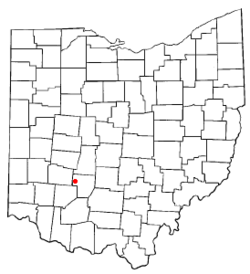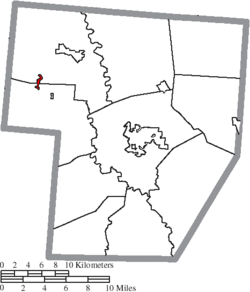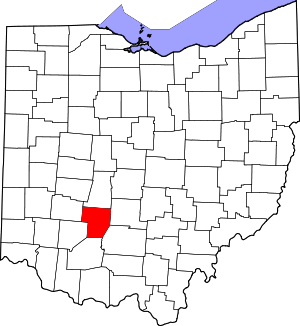Octa, Ohio
Octa is a village in Fayette County, Ohio, United States, along Rattlesnake Creek. The population was 59 at the 2010 census.
Octa, Ohio | |
|---|---|
 A large shopping center along US 35 on Octa's northern edge | |
 Location of Octa, Ohio | |
 Location of Octa in Fayette County | |
| Coordinates: 39°36′32″N 83°36′47″W | |
| Country | United States |
| State | Ohio |
| County | Fayette |
| Area | |
| • Total | 0.29 sq mi (0.75 km2) |
| • Land | 0.29 sq mi (0.75 km2) |
| • Water | 0.00 sq mi (0.00 km2) |
| Elevation | 1,043 ft (318 m) |
| Population | |
| • Total | 59 |
| • Estimate (2019)[4] | 58 |
| • Density | 200.00/sq mi (77.23/km2) |
| Time zone | UTC-5 (Eastern (EST)) |
| • Summer (DST) | UTC-4 (EDT) |
| FIPS code | 39-57918[5] |
| GNIS feature ID | 1065190[2] |
History
Octa was originally called Allentown, and under the latter name was laid out by Elijah Allen, and named for him.[6] The present name honors one Miss Octa Barnes.[7] A post office called Octa was established in 1882, and remained in operation until 1929.[8]
Geography
Octa is located at 39°36′32″N 83°36′47″W (39.608877, -83.613192).[9]
According to the United States Census Bureau, the village has a total area of 0.28 square miles (0.73 km2), all of it land.[10]
Demographics
| Historical population | |||
|---|---|---|---|
| Census | Pop. | %± | |
| 1900 | 123 | — | |
| 1910 | 91 | −26.0% | |
| 1920 | 107 | 17.6% | |
| 1930 | 64 | −40.2% | |
| 1940 | 67 | 4.7% | |
| 1950 | 87 | 29.9% | |
| 1960 | 95 | 9.2% | |
| 1970 | 102 | 7.4% | |
| 1980 | 74 | −27.5% | |
| 1990 | 78 | 5.4% | |
| 2000 | 83 | 6.4% | |
| 2010 | 59 | −28.9% | |
| Est. 2019 | 58 | [4] | −1.7% |
| U.S. Decennial Census[11] | |||
2010 census
As of the census[3] of 2010, there were 59 people, 30 households, and 13 families living in the village. The population density was 210.7 inhabitants per square mile (81.4/km2). There were 34 housing units at an average density of 121.4 per square mile (46.9/km2). The racial makeup of the village was 84.7% White and 15.3% African American. Hispanic or Latino of any race were 1.7% of the population.
There were 30 households, of which 16.7% had children under the age of 18 living with them, 26.7% were married couples living together, 6.7% had a female householder with no husband present, 10.0% had a male householder with no wife present, and 56.7% were non-families. 50.0% of all households were made up of individuals, and 20% had someone living alone who was 65 years of age or older. The average household size was 1.97 and the average family size was 2.85.
The median age in the village was 45.8 years. 20.3% of residents were under the age of 18; 6.9% were between the ages of 18 and 24; 20.4% were from 25 to 44; 28.9% were from 45 to 64; and 23.7% were 65 years of age or older. The gender makeup of the village was 49.2% male and 50.8% female.
2000 census
As of the census[5] of 2000, there were 83 people, 36 households, and 20 families living in the village. The population density was 291.2 people per square mile (110.5/km2). There were 39 housing units at an average density of 136.8 per square mile (51.9/km2). The racial makeup of the village was 93.98% White and 6.02% African American. Hispanic or Latino of any race were 4.82% of the population.
There were 36 households, out of which 25.0% had children under the age of 18 living with them, 47.2% were married couples living together, 5.6% had a female householder with no husband present, and 41.7% were non-families. 33.3% of all households were made up of individuals, and 13.9% had someone living alone who was 65 years of age or older. The average household size was 2.31 and the average family size was 3.00.
In the village, the population was spread out, with 20.5% under the age of 18, 6.0% from 18 to 24, 34.9% from 25 to 44, 25.3% from 45 to 64, and 13.3% who were 65 years of age or older. The median age was 41 years. For every 100 females there were 130.6 males. For every 100 females age 18 and over, there were 135.7 males.
The median income for a household in the village was $40,250, and the median income for a family was $40,417. Males had a median income of $21,667 versus $22,083 for females. The per capita income for the village was $15,846. There were 9.5% of families and 8.1% of the population living below the poverty line, including 9.5% of under eighteens and none of those over 64.
References
- "2019 U.S. Gazetteer Files". United States Census Bureau. Retrieved July 28, 2020.
- "US Board on Geographic Names". United States Geological Survey. 2007-10-25. Retrieved 2008-01-31.
- "U.S. Census website". United States Census Bureau. Retrieved 2013-01-06.
- "Population and Housing Unit Estimates". Retrieved May 21, 2020.
- "U.S. Census website". United States Census Bureau. Retrieved 2008-01-31.
- Allen, Frank M. (1914). History of Fayette County, Ohio: Her People, Industries and Institutions. B. F. Bowen, Incorporated. p. 299.
- Overman, William Daniel (1958). Ohio Town Names. Akron, OH: Atlantic Press. p. 103.
- "Fayette County". Jim Forte Postal History. Retrieved 13 December 2015.
- "US Gazetteer files: 2010, 2000, and 1990". United States Census Bureau. 2011-02-12. Retrieved 2011-04-23.
- "US Gazetteer files 2010". United States Census Bureau. Archived from the original on 2012-07-02. Retrieved 2013-01-06.
- "Census of Population and Housing". Census.gov. Retrieved June 4, 2015.
Further reading
- Steinmetz, Robert, A Train Ran Through It: A Boy's Life in Octa, Ohio, 1940-1953, and History and Culture of the Rural Village and Region, Amazon Books, 2018, p. 173.
